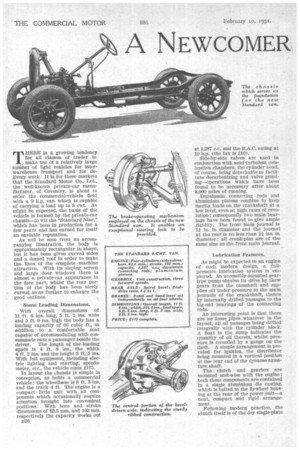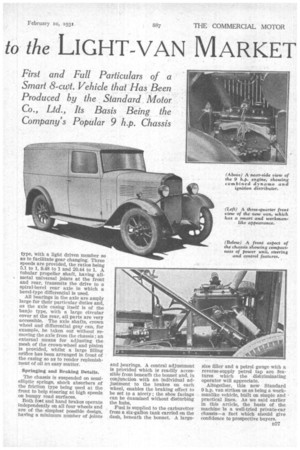A NEWCOMER
Page 88

Page 89

If you've noticed an error in this article please click here to report it so we can fix it.
to the LIGHT-VAN MARKET
First and Full Particulars of a Smart 8-cwt. Vehicle that Has Been Produced by the Standard , Motor Co., Ltd., Its Basis Being the
Company's Popular 9 h.p. Chassis T. HERE is a growing tendency for all classes of trader to .make use of a relatively large number of light vehicles for interwarehouse transport and for delivery work. It is for these markets that the Standard Motor Co., Ltd., the well-known private-car manufacturer, of Coventry, is about to enter the commercial-vehicle field with a 9 h.p. van which is capable of carrying a load up to 8 cwt. As might be expected, the basis of the vehicle is formed by the private-car chassis—to wit the "Standard Nine," which has been in production for a few years and has earned for itself an enviable reputation.
As will be seen from an accompanying illustration, the body is approximately rectangular in shape, but it has been given curved skies and a domed roof in order to make the lines of the complete machine attractive. With its sloping screen and large door windows there is almost a private-car, appearance in the fore part, whilst the rear portion of the body has been nicely cntwed so as further to enhance the good outlines. .
Some Leading Dimensions.
With overall dimensions of 11 ft. 6 ins. long, 5 ft. 2 ins. wide and 5 ft. 9 ins, high the body, has a loading capacity of 66 cubic ft., in addition to a comfortable seat capable of accommodating with consuminate ease a passenger beside the driver. The length of the loading space is 4 ft. 8 ins., the width 4 ft. 2 ins, and the height 8 ft. 5 ins. With full equipment, including electric lighting and starting, speedometer, etc., the vehicle costs £175.
In layout the chassis is simple in conception, as befits a commercial vehicle; the wheelbase is 8 ft. 3 ins. and the track 4 ft. The engine is a compact tittle unit with all coniponents which occasionally require attention brought into convenient positions. With bore and stroke dimensions of 63.5 mm. and 102 mm. respectively the capacity works out D26 at 1,28T c.c. and the R.A.C. rating at 10 ii.p. (the tax is i10).
Side-by-side valves are used in conjunction with semi-turbulent combustion chambers, the cylinder head, of Course, being detachable to facilitate decarbonizing and valve grinding—operations which have been found to be necessary after about 8,000 miles of running.
Duralumin connecting rods and aluminium pistons combine to keep inertia loads on the crankshaft at a low level, even at high rates of revolution; consequently two main_ bearings have been found to give ample rigidity. The front main journal is 1i in. in diameter and the journal at tho rear is no less than 2i ins, in diameter; all crank-pins are of the same size as the front main journal.
Lubrication Features.
As might be expected in an engine of such modern design, a fullpressure lubrication system is employed. An accessibly mounted geartype pump obtains its drive by skew gears from the camshaft and supplies oil under pressure to the main journals of the crankshaft, thence by internally drilled passages to the big-end bearings of the connecting rods.
An interesting point is that there are no loose pipes whatever in the layout, all oil passages being drilled integrally with the cylinder block. A float in the SWIM indicates the quantity of oil therein, whilst pressure is recorded by a gauge on the dash. A simple arrangement is provided for ignition, the distributor being mounted in a vertical position at the rear end of the dynamo armature shaft.
The clutch and gearbox are mounted unit-wise with the engine ; both these components are contained in a single aluminium die casting, which is bolted to the flywheel housing at the rear of the power unit—a neat, compact and rigid arrangeinent.
Following modern practice, the clutch itself is of the dry single-plate type, with a light driven member so as to facilitate gear changing. Three speeds are provided, the ratios being 5.1 to 1, 9.48 to 1 and 20.44 to 1. A. tubular propeller shaft, having allmetal universal joints at the front and rear, transmits the drive to a spiral-bevel rear axle in which a bevel-type differential is used.
All bearings in the axle are amply large for their particular duties and, as the axle casing itself is of the banjo type, with a large circular cover at the rear, all parts are very accessible. The axle shafts, crown wheel and differential gear can, for example, be taken out without removing the axle from the chassis ; an external means for adjusting the mesh of the crown-wheel and pinion is provided, whilst a large filling orifice has been arranged in front of the casing so as to render replenishment of oil an easy matter.
Springing and Braking Details.
The chassis is suspended on semielliptic springs, shock absorbers of the friction type being used at the front to help steering at high speeds on bumpy road surfaces.
Both foot and hand brakes operate independently on all four wheels and are of the simplest possible design, having a minimum number of joints and bearings. A. central adjustment is provided which is readily accessible from beneath the bonnet and, in conjunction with an individual adjustment to the brakes on each wheel, enables the braking effect to be set to a nicety ; the shoe facings can be examined without disturbing the hubs.
Fuel is supplied to the carburetter from a six-gallon tank carried on the dash, beneath the bonnet. A large
size filler and a petrol gauge with a reverse-supply petrol tap are features which the digcriminating operator will appreciate. Altogether, this new Standard h.p. van strikes us as being a workmanlike vehicle, built on simple and practical lines. As we said earlier in this article, the basis of the machine Is a well-tried private-car chassis—a fact which should give confidence to prospective buyers.




























































































































































































